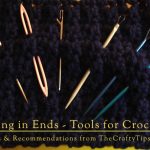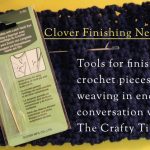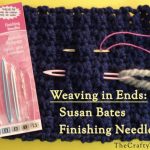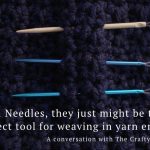In my first of a series of posts about the various tools used when weaving in ends, today I’ll talk about sewing needles.
If you think sewing needles only work with sewing thread and are only straight pointy things, I’m here to show you just how cool sewing needles can be.
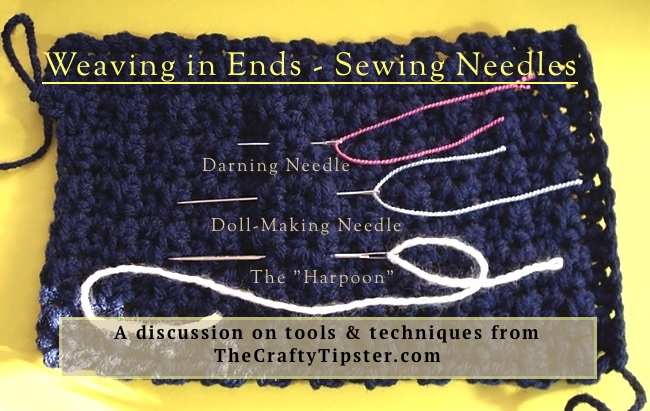
These are a few of the sewing needles I use with my crochet pieces.
The first is a traditional darning needle. It’s my weapon of choice when working with crochet thread.
The second one is a doll-making needle. It’s a lot longer but the eye isn’t all that much bigger than the darning needle.
And, then there’s the one I’ve knick-named the “Harpoon”. It has an eye big enough to put most smooth yarns through fairly easily but it is too big around and quite long for delicate work. It is particularly useful for projects where going through a stuffed piece from top to bottom creates the shaping, think pumpkins and amigurumi. But, it is wicked huge, with a great big pointy tip. It has gotten me a few times and I use it only as a last resort.
Tip from the Tipster
Speaking of last resorts…While this would make at least one “mommy blogger” run for the hills for fear of getting stuck, I have been known to deploy a pair of pliers to assist in grabbing the needle and pulling it through a tight spot. Sometimes, the needle with the two thicknesses of yarn simply gets stuck in between the stitches. No amount of tugging will get that stinker out. It won’t go backwards or forwards. My trusty pliers to the rescue. I have had sewing needles wear out and break, but, I’ve never had that happen when my not so fine adjustment tool was in play.
Why I Like Using Sewing Needles to Weave in Ends on Crochet
- Sleek and small enough shafts to easily slide between the tightest of stitches with the smallest crochet yarns and threads.
- Causes very little disruption to the stitches when working the ends back and forth.
- Sewing and darning needles can be purchased virtually anywhere for as little as $1 a package.
Why Sewing Needles Fall Short as the Perfect Tool for Weaving in Ends
- Very few of the needles, with large enough eyes for crochet thread, come in a “sharp” tipped version.
- The needles, that are sharp and have larger eyes, are often too thick to work between the threads.
- Not really an option for thicker or fuzzier yarns.
Specialty Sewing Needles
There are a number of specialty sewing needles that change the shape of the shaft of the needle to offer a different sewing experience. They all have their good points and bad for working with crochet.
Doll Making Needles
Doll making needles offer the traditional feel of a sewing needle but are longer than most darning or hand-sewing needles. Their purpose is to sew completely through a stuffed doll or toy.
These needles usually have sharp tips and medium-sized eyes. They can range in size from 3-5 inches. I’ve seen a few that were even longer. It’s the length of these that makes them less suitable for weaving in ends. You’ll need a fairly long tail – too much yarn wastage for me.
They are useful for their intended use – shaping stuffed items. With sport or finer yarns and threads, they work well for creating facial features in dolls and puckered ends in apples and small pumpkins.
Curved Needles
Curved needles were originally made for upholstery work. The idea behind them is you can stitch something when you can’t access the back side – think of repairing a couch or top-stitching on a stuffed crochet piece. I’ve had mixed results with these. They are readily available. Many stores, even general department stores, have little packages of “home repair” needles that include a curved needle, like this one from Singer.
These are indeed interesting. They do exactly what they’re meant to do. Unfortunately, I had a lot of trouble working with them. The needle kept flipping over on its side and was really fiddly to insert into the stitches. Most of the ones I tried were on the long size and perhaps a shorter one would work better for crochet.
My biggest issue with the curved needles was that you could only slide them through 1-3 stitches at a time. I like sliding the needle underneath as many stitches as I can along the needle shaft. Between the twisty nature of the curved needles and the limited amount of threads it can be slid under at a time, decrease productivity greatly.
They do generally have a bigger eye and would work with more types of materials.
I would recommend if you want to try these, that you buy a product that offers an assortment of needle types. These needles may be a little more fragile than straight needles. If you find you like working with the curved needles and might make them a regular part of your crochet, then I would invest in ones made by John James or Clover – two of the better needle companies; in my opinion.
Sack Needles
These are truly the harpoons of sewing needles. They have a fan-like blade at the tip and were designed to work with leather and boat sails. They have a dual function – awl and needle in one. I thought the small and sharp tip design might allow for precision placement in tiny places. The blade part would then separate the stitches to make room for the eye and yarn.
Mine was super cheap. I was always worried that the blade sides would slice through fibers. I also found it tended to twirl and cause the wide blade to get caught on stitches. Plus, my cheapo one felt a bit rough. I was afraid it would snag.
The Singer pack that I’ve shared from Amazon contains a sack needle too.
These apparently come in a variety of sizes. The one I played with had a large blade. I didn’t like it for a number of reasons. Ironically, I couldn’t even find mine to photograph for this post.
Bent Tip Needles for Weaving in Ends with Crochet
I purchased these several years ago thinking they would be the perfect thing for weaving in ends. They aren’t as fiddly as the curved needles. However, I found you can pretty much only slide them under as many threads as will fit on the bent part.
I have only worked with the typical gold Clover ones carried by most craft stores. They are a good size for larger yarns and the eye is quite large. They were smooth like aluminum crochet hooks. The tips are blunt and quite large.
If you like finishing your crochet (yep, we have a tutorial for that) or knit pieces by simply winding a long tail around the stitches, I think a bent tip needle would work wonderfully. It would lift up the pair of loops and easily slide underneath without splitting the threads of the stitches.
In writing this post, I came across “huck needles.” They are a version of bent tip needles that are made for huck embroidery – think of that stretchy smocking stitches that help keep sundresses on without straps. The points look fairly pointy and the eyes look big too. The bend is a bit more subtle which might make them better for weaving in between stitches. I haven’t tried them yet, but, they will likely be part of my next Amazon order.
Plastic Needles
Sure they are child safe. Sure they are cheap. I think they are garbage for working with crochet. They don’t slide nicely between the threads. They have huge eyes and blunt tips. And, they are bendy. They are hard to thread. Don’t waste your money, buy one of the others. If you’re worried about children using them, buy one of the larger, blunt-tipped needles instead.
Still My Choice for Crochet Thread & Fine Yarns
Even now that I have such a wide variety of needles to choose from, when it comes to crochet thread, it’s darning needles all the way. The other finishing and wool needles just have shafts that are too large to slip in between tight stitches. I’m still hunting for a favorite that combines the needle thickness, eye size and sharp point I want. I will let you know when I find it.
In later posts, I’ll be sharing with you some of the other tools I have tried for weaving in ends; including, my new favorite for thicker and fluffier yarns; and one I wish I hadn’t wasted my money on.
Check out my reviews of Susan Bates Finishing Needles and the Clover Darning Needles with Latch Hook Eyes.
